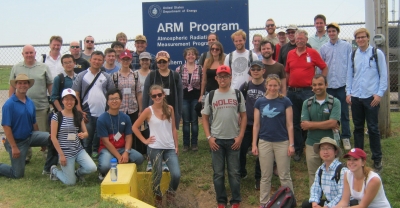Students Explore the Skies at ARM Summer Training
Published: 21 August 2015

Their heads were in the clouds, but the students at the first ARM Summer Training and Science Applications event weren’t daydreaming. As the next generation of atmospheric researchers, they cut their teeth on ARM data at the National Weather Center in Norman, Oklahoma, from July 15 to 24. Their experience included visiting ARM’s Southern Great Plains (SGP) site—one of the most comprehensive instrument suites in the world—and using data collected at the SGP site for their project work on observations and modeling of aerosol, clouds, and precipitation.
Twenty-six graduate students from around the world participated in the training. Each morning, they attended two lectures and discussion sessions before breaking into working groups where they focused on different applications for the data obtained from the SGP and other ARM sites.
“We made sure to mix up the groups. For example, we paired students interested in aerosols with those whose focus is clouds and assigned the students in working groups unrelated with their past education,” lead instructor Pavlos Kollias, McGill University, explained.
“It led to some really great ideas, and the separate groups became quite spirited and focused. They would actually leave the room to work somewhere else, away from each other, before meeting back up to share final results.”
The students were chosen from a highly talented pool of around 90 applicants and selecting them was a hard decision for instructors to make.
“The students were some of the best in their fields, and we were extremely happy with their engagement and what they got out of the training,” said Dave Turner, NOAA National Severe Storms Laboratory. “They had enough background that they could understand the importance of ARM, and it was great to see the moment it dawned on them how complex and rich ARM data could be.”
Turner was another lead instructor of the event. Working together, Turner, Kollias, and Susanne Crewell of the University of Cologne at Germany, initiated the summer training, which featured a total of 12 instructors, including research scientists, professors, and engineers from agencies, universities, and national laboratories from around the world. The event leaders were inspired by the Initial Training for Atmospheric Remote Sensing (ITaRS), a similar training session held in Europe under Crewell’s leadership, and plan to alternate future ARM trainings with the ITaRS.
“There’s no graduate program in the US that exposes students to hands-on training and scientific applications with even the core sensors of the ARM Facility,” Kollias said. “The ARM training provides an experience you won’t get in a classroom or from a textbook. We need to expose young, upcoming scientists to the ARM program to broaden the user community that can collaborate and use ARM data for amazing things.”
# # #
The ARM Climate Research Facility is a national scientific user facility funded through the U.S. Department of Energy’s Office of Science. The ARM Facility is operated by nine Department of Energy national laboratories, including Argonne National Laboratory, which manages the SGP site.
The ARM Climate Research Facility is a DOE Office of Science user facility. The ARM Facility is operated by nine DOE national laboratories, including .
Keep up with the Atmospheric Observer
Updates on ARM news, events, and opportunities delivered to your inbox
ARM User Profile
ARM welcomes users from all institutions and nations. A free ARM user account is needed to access ARM data.


















